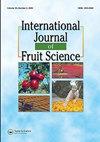The Effects of Different Rootstocks on the Graft Success and Stion Development of Some Pear Cultivars
IF 2.4
3区 农林科学
Q2 HORTICULTURE
引用次数: 6
Abstract
ABSTRACT In modern pear growing, quince and pear clonal rootstocks are used instead of pear seedlings. This study aimed to evaluate the effect of different quince and pear rootstocks on the graft success and the stion (scion+rootstock) growth performance of some pear cultivars/genotypes. In the study, quince (Quince BA 29, Quince A and Quince MC), pear (OHxF 333, Fox 11, Farold 40) clones and pear seedlings were grafted in two standard (Deveci and Williams) and 11 local (‘Bardak,’ ‘Dalkıran,’ ‘Eşek,’ ‘İstanbul,’ ‘Kara,’ ‘Karga,’ ‘Karpuz,’ ‘Kış,’ ‘Sarıkum,’ ‘Tefenc’ and ‘Yaz Ziraati’) promising pear cultivars were used. Significant differences were observed in both rootstocks and varieties in terms of graft success and plant development in the study. The graft take, sprout and survival ratios were higher in pear rootstocks than in the quince rootstocks. While the highest graft survival ratio was observed in Fox 11, the lowest was in the BA 29 quince rootstock. The highest graft sprout and graft survival ratio were in ‘Deveci,’ the lowest in ‘Williams,’ ‘Bardak’ and ‘Kış’ varieties. While the highest shoot lengths and highest diameters were detected in the pear seedling, the lowest were in the MC rootstock. While the longest shoots were observed in ‘Kara,’ the thickest shoots were observed in ‘Eşek’ genotypes. As a result of this study, it was determined that the 13 pear cultivars/genotypes grafted on different rootstocks were sufficient in terms of graft success and stion growth performances and it was found that stion of sufficient quality could be grown in the field condition.不同砧木对部分梨品种嫁接成功及立枝发育的影响
摘要在现代梨的种植中,使用榅桲和梨无性系砧木代替梨苗。本研究旨在评价不同砧木对部分梨品种/基因型嫁接成功率及接穗+砧木生长性能的影响。本研究以quince (quince BA 29、quince A和quince MC)、梨(OHxF 333、Fox 11、Farold 40)无性系和梨苗嫁接在2个标准品种(Deveci和Williams)和11个地方品种(' Bardak '、' Dalkıran '、' e ek '、' Kara '、' Karga '、' Karpuz '、' Kış '、' Sarıkum '、' Tefenc '和' Yaz Ziraati ')上。砧木和品种在嫁接成功率和植株发育方面存在显著差异。梨砧木的接枝率、出芽率和成活率均高于太子砧木。嫁接成活率最高的是Fox 11,最低的是BA 29。接枝出芽率和成活率最高的品种是‘Deveci’,最低的品种是‘Williams’、‘Bardak’和‘Kış’。梨苗的茎长和茎径最高,而MC砧木的茎长和茎径最低。在‘Kara’基因型中观察到最长的芽,而在‘e ek’基因型中观察到最粗的芽。结果表明,嫁接在不同砧木上的13个梨品种/基因型在嫁接成功率和立地生长性能方面都是足够的,在田间条件下可以培育出质量足够的立地。
本文章由计算机程序翻译,如有差异,请以英文原文为准。
求助全文
约1分钟内获得全文
求助全文
来源期刊

International Journal of Fruit Science
Agricultural and Biological Sciences-Agronomy and Crop Science
CiteScore
6.40
自引率
0.00%
发文量
64
审稿时长
10 weeks
期刊介绍:
The International Journal of Fruit Science disseminates results of current research that are immediately applicable to the grower, extension agent, and educator in a useful, legitimate, and scientific format. The focus of the journal is on new technologies and innovative approaches to the management and marketing of all types of fruits. It provides practical and fundamental information necessary for the superior growth and quality of fruit crops.
This journal examines fruit growing from a wide range of aspects, including:
-genetics and breeding
-pruning and training
-entomology, plant pathology, and weed science
-physiology and cultural practices
-marketing and economics
-fruit production, harvesting, and postharvest
 求助内容:
求助内容: 应助结果提醒方式:
应助结果提醒方式:


